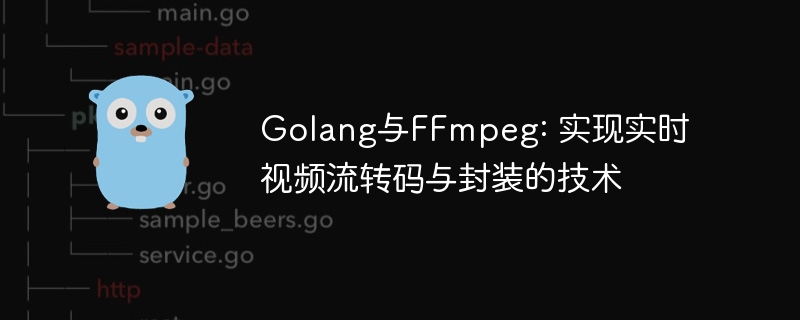Golang 및 FFmpeg: 실시간 비디오 스트리밍 트랜스코딩 및 캡슐화 기술
- WBOYWBOYWBOYWBOYWBOYWBOYWBOYWBOYWBOYWBOYWBOYWBOYWB원래의
- 2023-09-28 22:30:481345검색

Golang 및 FFmpeg: 실시간 비디오 스트림 트랜스코딩 및 캡슐화를 구현하는 기술, 특정 코드 예제가 필요합니다.
개요:
오늘날 인터넷 시대에 비디오는 사람들의 삶에 없어서는 안 될 부분이 되었습니다. 하지만 영상 포맷의 불일치, 네트워크 환경의 차이로 인해 네트워크를 통해 영상을 직접 전송하는 경우 전송 속도가 느리거나 영상 품질이 저하되는 등의 문제가 발생하는 경우가 많습니다. 이러한 문제를 해결하기 위해 비디오 트랜스코딩 및 캡슐화 기술을 사용하여 비디오 스트림을 인코딩 및 디코딩하고 이를 네트워크 전송에 적합한 형식으로 캡슐화할 수 있습니다. 이 기사에서는 Golang 및 FFmpeg를 사용하여 실시간 비디오 스트림 트랜스코딩 및 캡슐화 기술을 구현하는 방법을 소개하고 구체적인 코드 예제를 제공합니다.
기술적 배경:
Golang은 높은 동시성, 단순성, 사용 용이성, 빠른 컴파일이라는 특징을 지닌 강력한 프로그래밍 언어입니다. FFmpeg는 거의 모든 일반적인 오디오 및 비디오 형식을 처리할 수 있는 크로스 플랫폼 오디오 및 비디오 처리 도구입니다. Golang과 FFmpeg를 결합하면 효율적인 비디오 스트림 트랜스코딩 및 캡슐화를 달성할 수 있습니다.
구체적인 구현 단계:
- 필요한 라이브러리 소개
먼저 Golang에 FFmpeg 관련 라이브러리를 소개합니다. Golang에서는 cgo를 사용하여 C 언어 라이브러리를 호출할 수 있습니다. go get 명령을 통해 FFmpeg 관련 라이브러리를 얻을 수 있습니다. - 비디오 입력 스트림 열기
FFmpeg의 avformat_open_input 함수를 사용하여 비디오 입력 스트림을 엽니다. 이 함수는 입력 스트림의 주소, 입력 스트림의 캡슐화 형식 및 기타 관련 매개변수를 전달해야 합니다. - 비디오 스트림 정보 찾기
FFmpeg의 avformat_find_stream_info 함수를 사용하여 비디오 스트림 형식, 인코더, 프레임 속도 등과 같은 입력 스트림에 대한 관련 정보를 찾습니다. 이 함수는 AVFormatContext 구조의 관련 정보를 채웁니다. - 비디오 출력 스트림 열기
FFmpeg의 avformat_alloc_output_context2 함수를 사용하여 비디오 출력 스트림의 컨텍스트를 생성하세요. 이 함수는 출력 스트림의 캡슐화 형식과 출력 파일 이름을 전달해야 합니다. - 비디오 스트림 정보 추가
입력 스트림 정보를 출력 스트림에 복사합니다. - 출력 파일 열기
FFmpeg의 avio_open2 함수를 사용하여 출력 파일을 엽니다. 이 함수에는 출력 스트림의 컨텍스트, 출력 파일 이름 및 기타 관련 매개변수가 필요합니다. - 인코딩 및 캡슐화
루프를 통해 비디오 스트림의 각 프레임 데이터를 읽은 다음 프레임 데이터를 인코딩합니다. 비디오 프레임은 FFmpeg의 avcodec_encode_video2 함수를 사용하여 인코딩할 수 있습니다. 인코딩이 완료된 후 FFmpeg의 av_interleaved_write_frame 함수를 사용하여 인코딩된 데이터를 출력 파일에 씁니다. - 입력 및 출력 스트림을 닫습니다.
비디오 스트림 순회가 완료되면 FFmpeg의 av_write_trailer 함수를 사용하여 비디오 캡슐화를 완료합니다. 마지막으로 입력 및 출력 스트림을 닫고 리소스를 해제합니다.
특정 코드 예:
package main
// 导入FFmpeg相关的头文件
/*
#cgo LDFLAGS: -lavformat -lavcodec -lavutil
#include <libavformat/avformat.h>
#include <libavcodec/avcodec.h>
*/
import "C"
import (
"fmt"
)
func main() {
// 输入文件名和输出文件名
inputFileName := "input.mp4"
outputFileName := "output.mp4"
// 打开输入文件流
var inputFormatCtx *C.AVFormatContext
if C.avformat_open_input(&inputFormatCtx, C.CString(inputFileName), nil, nil) != 0 {
fmt.Printf("Failed to open input file
")
return
}
// 查找视频流信息
if C.avformat_find_stream_info(inputFormatCtx, nil) < 0 {
fmt.Printf("Failed to find stream information
")
return
}
// 打开输出文件流
var outputFormatCtx *C.AVFormatContext
C.avformat_alloc_output_context2(&outputFormatCtx, nil, nil, C.CString(outputFileName))
if outputFormatCtx == nil {
fmt.Printf("Failed to allocate output format context
")
return
}
// 复制视频流信息到输出流
for i := C.uint(0); i < inputFormatCtx.nb_streams; i++ {
stream := inputFormatCtx.streams[i]
outputStream := C.avformat_new_stream(outputFormatCtx, stream.codec.codec)
if outputStream == nil {
fmt.Printf("Failed to allocate output stream
")
return
}
// 复制流的参数
if C.avcodec_parameters_copy(outputStream.codecpar, stream.codecpar) < 0 {
fmt.Printf("Failed to copy codec parameters
")
return
}
}
// 打开输出文件
if C.avio_open(&outputFormatCtx.pb, C.CString(outputFileName), C.AVIO_FLAG_WRITE) < 0 {
fmt.Printf("Failed to open output file
")
return
}
// 写入文件头部
if C.avformat_write_header(outputFormatCtx, nil) < 0 {
fmt.Printf("Failed to write header
")
return
}
// 读取视频流数据并进行编码处理
packet := C.AVPacket{}
for C.av_read_frame(inputFormatCtx, &packet) == 0 {
stream := inputFormatCtx.streams[packet.stream_index]
outStream := outputFormatCtx.streams[packet.stream_index]
// 编码帧数据
if C.avcodec_send_packet(stream.codec, &packet) < 0 || C.avcodec_receive_packet(stream.codec, &packet) < 0 {
fmt.Printf("Error while encoding
")
return
}
packet.stream_index = outStream.index
packet.pts = C.AV_NOPTS_VALUE
packet.dts = C.AV_NOPTS_VALUE
// 封装编码后的数据
if C.av_interleaved_write_frame(outputFormatCtx, &packet) < 0 {
fmt.Printf("Error while writing frame
")
return
}
C.av_packet_unref(&packet)
}
// 结束封装
C.av_write_trailer(outputFormatCtx)
// 关闭输入输出流
C.avformat_close_input(&inputFormatCtx)
if outputFormatCtx != nil && outputFormatCtx.pb != nil {
C.avio_close(outputFormatCtx.pb)
}
C.avformat_free_context(outputFormatCtx)
fmt.Printf("Done
")
}요약:
Golang 및 FFmpeg를 사용하면 실시간 비디오 스트림의 트랜스코딩 및 캡슐화를 쉽게 달성할 수 있습니다. 이 문서에서는 구체적인 코드 예제를 제공하고 구현 단계를 간략하게 설명합니다. 그러나 실제 프로젝트에서는 예외 처리, 동시성 처리 등 더 자세한 사항을 고려해야 할 수도 있습니다. 이 글이 실시간 비디오 스트림 트랜스코딩과 캡슐화 기술을 처음 접하는 분들에게 도움이 되기를 바라며, 모든 분들께 학습 방향과 아이디어를 제공할 수 있기를 바랍니다.
위 내용은 Golang 및 FFmpeg: 실시간 비디오 스트리밍 트랜스코딩 및 캡슐화 기술의 상세 내용입니다. 자세한 내용은 PHP 중국어 웹사이트의 기타 관련 기사를 참조하세요!

